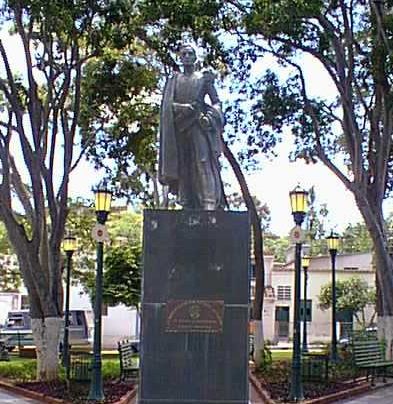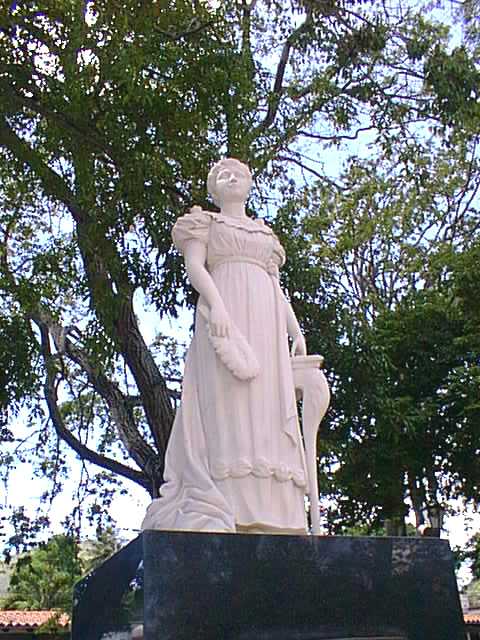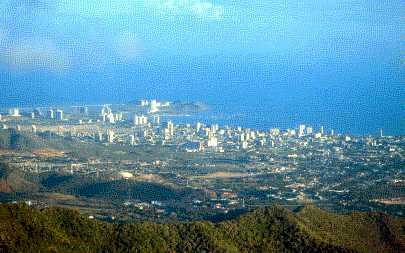Margarita Island History
I will always remember the summer '67. It was an anxious moment I had being waiting so long for my graduation from High School.I had spent four years of academic and military work in Miami, Florida. The feeling of having achieved this as a foreigner, made it even greater. I was ready for vacation! That summer a friend of mine had invited me to stay with his family at a hotel in Margarita Island : Tony Ariza
The Isle is located 23 miles northeast of Venezuela's Mainland, 23th State of the country, completely surrounded by the Caribbean Sea, 11º north of the Equator and 64º west from Greenwich. Average temperature 87ºF. We are out of the Hurricane Path. Area: 363 sq. miles or 941 sq. Km.. Everlasting summer time...
Since my home town is Caracas, after a few days there I was ready to discover the Isle..... The Hotel Bella Vista was luxorious at that time and made my stay very pleasant. By being in Margarita Island, was meant that "we tourists" spent the night in Porlamar, then only in downtown a few roads were paved. Never mind the rest of the island were you had to drive 4x4 vehicles. (fabulous!!!) The Ferry, as we know it today didn't exist so the isle was never busy with cars. The only rush hour we ever experienced was after breakfast when we ran towards the hotel's beach.
We felt ourselves in paradise, among the natives...!
More than 1,000 years have the Guaiquerí Indians lived here doing what they do best. Fishing. Friendly and peaceful people, willing to help, but the 20th century struck leaving poverty behind them. Many of them left their families for long years, just to find a new hope or better incomes through the oil industries on the mainland. During the year 1974 the government declared Margarita Island a Duty Free Port and domestic mass tourism began.
The islanders returned home....
Preamble of a Conquest
One of the characteristic features of the early history of Spain is the successive waves of different peoples who spread all over the Peninsula. From IBERIANS (Libyan people) - CELTS (Aryan people) - PHOENICIANS- GREEK settlers - CARTHAGINIANS (were called by the Phoenicians in their struggle against the Greek) - ROMANS (six centuries) - VISIGOTHS and last at the beginning of the 8th century the ARABS entered from thesouth, remaining until January 2th, 1492.
In 1469, the marriage of the Catholic Monarchs, Isabella of Castille and Ferdinand of Aragón, marked the opening of a period of growing success for Spain, since during their reign, Granada, after eight centuriesof Arabian rule, the last stronghold of the Moors in Spain was conquered (1492) and in the same historic year the caravels sent by the Crown of Castille under the command of Christopher Columbus discovered America.
In their account, we also find the setting up of the Inquisition : a Tribunal that not only had religious implications, but was also an instrument allowing royal power to reinforce the authority of the State.
"The next two centuries (16th and 17th ) witnessed the construction and apogee of the Spanish Empire, as a result of which the country, under the aegis of the Austrias, became the world's foremost power, and European politics hinged upon it...."
"... The fact that Christopher Columbus (Italian) appealed to a Castille's court to offer his services, proved that the discovery of America was not incidental.
Portugal and Castilla (Spain) were well-advanced in the exploration of overseas mercantile routes. We know that the African routes were closed to Castilla in favor of Portugal. In 1479, Alfonso V of Portugalrenounced his claims to Castilla and recognized the rights of Castilla over the Canary Islands, while Castilla recognized the rights of Portugal over the Azores, Cape Verde and Madeira.
The Canary Islands were an excellent bridgehead for alternate routes. This is what Christopher Columbus offered and he offered it to a State that needed them, but which was also accustomed to and prepared for this type of venture.
Unified Spain possessed in 1492 a powerful war machine, a solid economy an exterior projection, naval experience including the exploration of trade routes and notable scientific-technical potential mathematicians, geographers, astronomers and shipbuilders, who had been formed in a melting-pot of threecultures: Jews, Muslims and Christians."
...Its only rival was its neighbour : PORTUGAL
"...The Spanish were especially well prepared by history to conquer, occupy, populate and exploit new lands and assimilate new people. America thus became the new frontier-land for those people used to go "their way" and with the military, diplomats and administrative arms at their disposal to face the challenge."
After the second trip to America, Spain needed badly new incomes that would ensure the continuity of the Colonies in the New World; Columbus started his third trip to America, looking after gold and spices.....
On the early morning of august 15, 1498 before sunrise, he knew that it was the day of the Asencion and it would be just appropriate to name as such the island that stood in front of his eyes. He never landed on it instead, he was welcomed by the natives. While he wrote down the location of this isle, the natives, the Guaiquerí Indians approached the carabels, amazed by the size of their "canoes" "...it must be a sign of the Gods!" is probably the thought that went through their minds...
The meeting
A few months later, in the early 1499, the spanish Alonso de Ojeda following Columbus' Bitácora, landed on the isle exploring it unsuccessfully, due to his predominant attitude towards the Guaiqueries. During the same year, a second expedition took place, lead this time by Christopher de la Guerra and Alonso Niño. These gentlemen were capable of offering the natives a trustful communication, leading to the amazing fortune found underwater. Natural Pearls. They headed back taking with them a loaded coffer with Pearls, imagining the consequences this would bring.
No doubt that Christopher Columbus saw his dream come truth on October 12, 1492 , and as well for the Catholic Monarchs, who saw their kingdom grow in size and wealth. Now then everybody spoke about the "Pearl Island".
Starting the 16th Century in Spain, only a few year apart from the take of Granada, the adventurous spirit of mankind, motivated many men to sail towards a new hope in a new world.
The name had been changed to Margarita Island, so the spanish Monarchs said, to honor princess Margareth from Austria, who was to marry Prince Don Juan. This marriage never took place, since the prince died at an early stage. Hereafter Charles I of Spain and Charles V of Germany after the death of Fernando de Aragón in 1516, took over the Spanish Crown, plus the Italian and European dominions of the Habsburgs.
Meanwhile on the isle.....
The new settlers had learned that not only Margarita Island but a small 7 sq. miles island named Cubagua, only minutes away from Margarita Island, had enormous amounts of natural pearls.
The small isle is the opposite of Margarita : no water, no valleys or mountains, arid soil (desert) no trees and extremely hot. People had to exert themselves to the utmost in order to survive; but they had taken the draft that was to keep them awake : the avarice to become rich! Despite the hard living conditions, it is known, that about Cubagua Island King Charles I of Spain and Charles V of Germany officialy establish the very first settlement on South America : the city of Nueva Cadiz (1527). He also stablish in 1536 the city of "Puebla de la Mar", that later, after the Independence War (1817) became "Porlamar".
Pearls became wide spread among royal houses & european countries; for instance, we know that only during 1526 more than 6.000 pounds of natural pearls arrived in Spain! And not to mention the large amounts of pearls that got lost through the interference of pirates and bucaneers. During the 16th century, the spanish pioneers on the isle opened a trade-route with Spain and South America, standing out the breed of cattle.
Margarita Island became the "Gate" to South America.
Independence
1808-1813 The peninsular War: The Spanish people rose against french domination and with English help defeated Napoleon. Ferdinand VII was re-established in the spanish throne. They paid though a high price for it: ended up as a ruined and divided nation. In the American (Latin) Colonies, with all the struggle in the Peninsula, we sure took advantage and soon declared our independance. (1810) The conflict war lasted seven years in Margarita Island and 11 years in the venezuelan mainland. Chief General Commander Simón Bolívar (born in Caracas) lead us toward independence, as he also fought and won it for Colombia, Equador, Perú and Bolivia. General Pablo Morillo, an spanish triumphant during the six years war against Napoleon Bonaparte, wrote to his King Ferdinand VII, after he lead the spanish army toward a defeat, that marked the end of the war (on the isle) ... " the islanders fought like spartan warriors" After the war in 1817, Margarita Island, Coche Island and Cubagua Island became the new Estado Nueva Esparta. (New Spartan State) Names such as General Santiago Mariño and General Juan Bautista Arismendi among others born on this island's soil, are remembered today as leaders of the independance war. In our hearts lays the spirit of our heroine Luisa Cáceres de Arismendi, who sacrified herself and the life of her baby before turning her husband into the hands of the spanish army.
Today
Minimum income per month was set at 120.000 Bolívares (aprox. US$ 190 - Sept. '99) in the whole nation. The Islanders bring up their living today through Tourism, the Duty Free Port (almost no taxes) and fishing.
We estimate the total population of Margarita Is. at 360.000 habitants, whereby Porlamar is the largest and only "real-city", with 150.000 habitants. The remaining settlements, many of us would consider them as "towns", including the capital of the state: La Asunción. (Proclaimed by King Phillip III, 1600 AC) Here I recommend to visit the church-cathedral "Nuestra Señora de la Asunción" and the fortress "Santa Rosa".
Next to the fortress we find the water reservoir for the central area. This one collects running water from the mountains as mainly from the water pipelines (2) that come from the mainland, bringing today according to the government office INOS about 97 millions liters of water (25 million amer./gal ) every day. Since we are by service, due to the great amounts of running water in our Amazon (Venezuela), electrical power generates through hydro-electric power plants. Food & Other Supplies - due to price competition, it also arrives from the mainland through the ferry ships (every six hours, approx.)
In Porlamar, like in any major city, you will find attractive clothwear stores, jewelry (Gold & Diamonds from Venezuela). Naturaly the big buy on the isle are the Pearls; right outside La Asunción you find the Pearl center. Lively night life, which includes : Fine restaurants with fresh sea food & international meals, Casino & Slots, Live Shows - Discos - Pub Bars - Nightclubs - Strip-tease - and our amusement park "Diverland" with it's terrific Rollercoaster!
International tourism began short time ago, whereby most of the hotels were built among the last ten years... therefore you can imagine that we are "beginners" and it's true.
We are visited mostly by Europeans, Canadiens and South Americans. Flying straight to Margarita Island, is not always easy, unless is performed through a charter aircarrier or a domestic airline "Aeropostal" with a non-stop flight from Miami, FL - USA I must admit that we have done in the past a poor advertisement in USA. I said to myself: Let's do something about it!!
Saludos Amigos!!
Introduction to Margarita Island
by
Walter Gustav Molander
First published in 1998 by Arthur Frommer's Travel Newsletters





